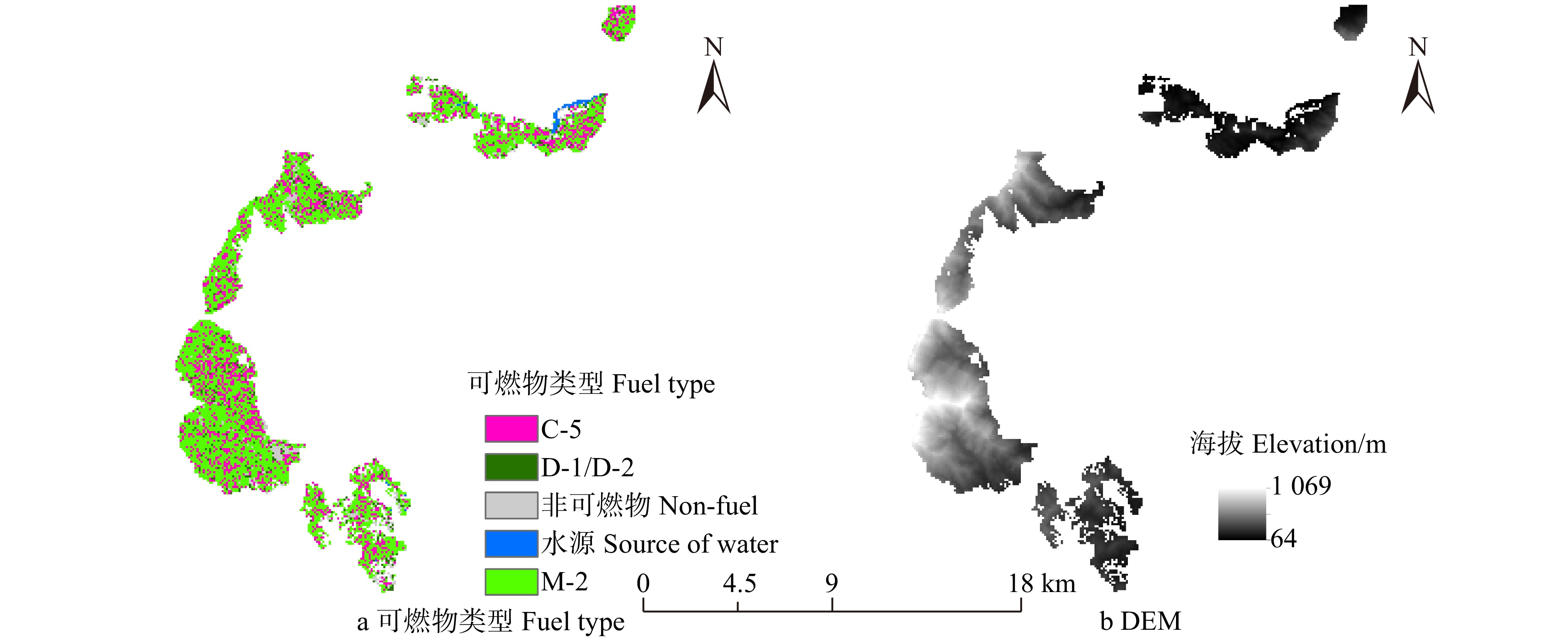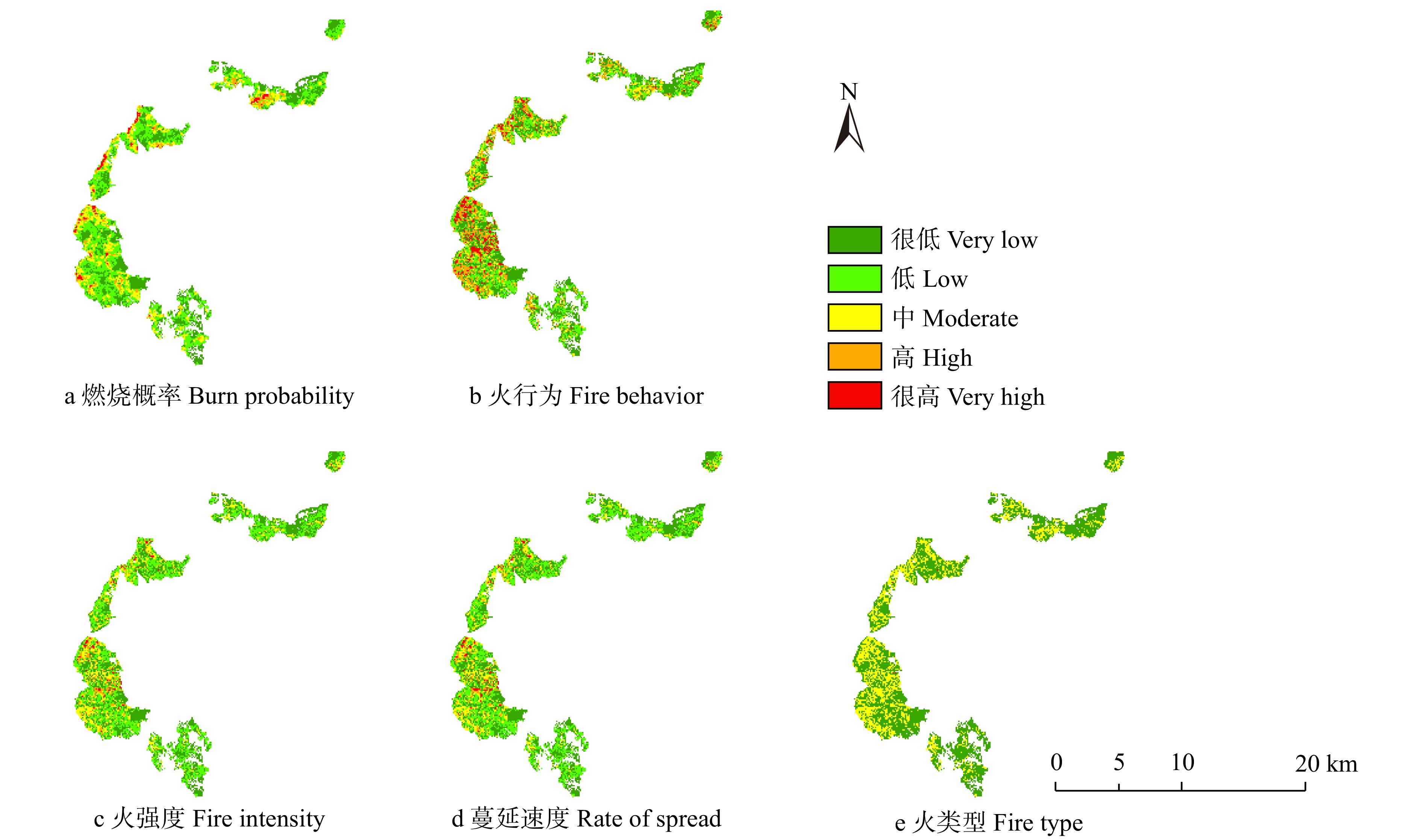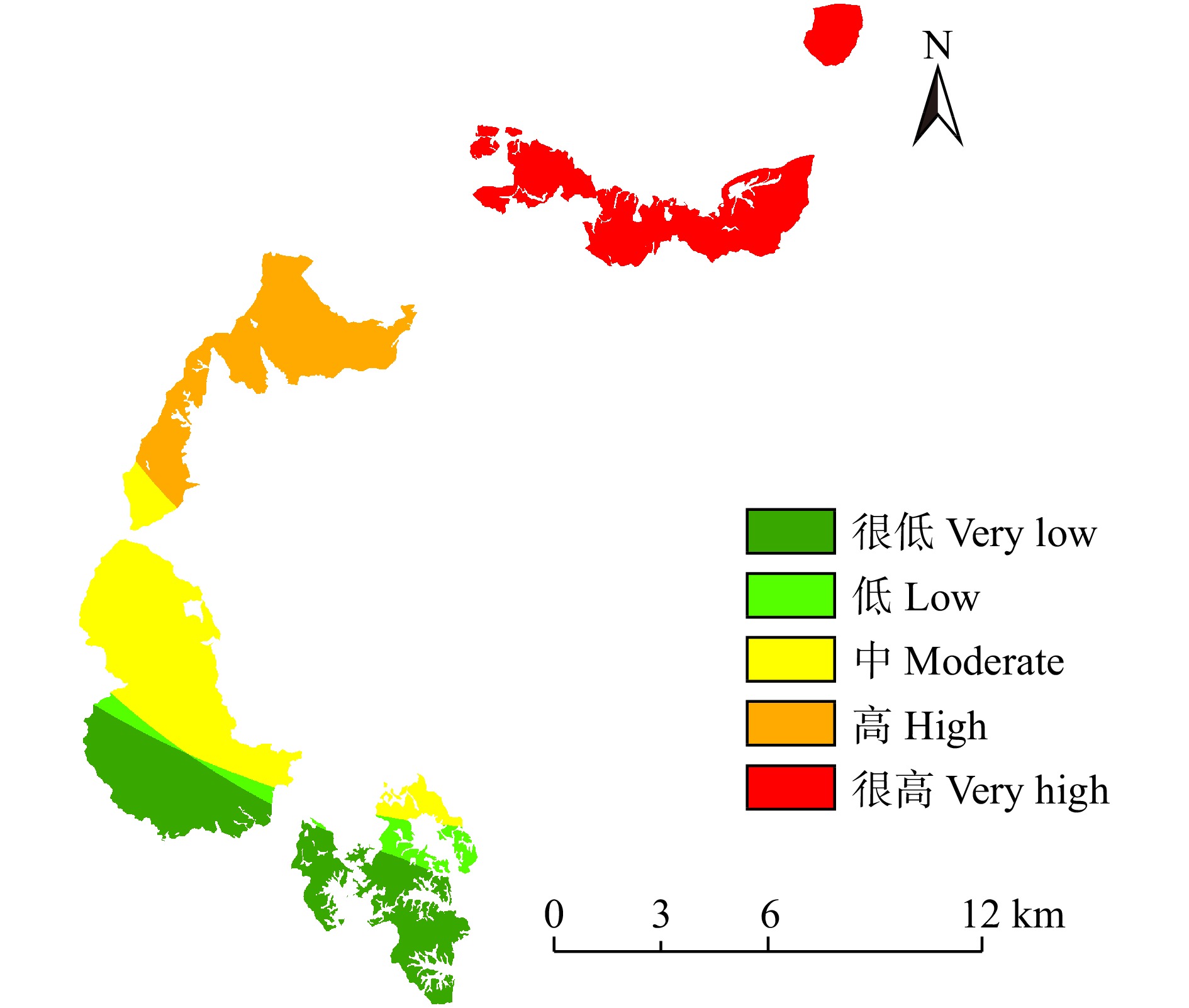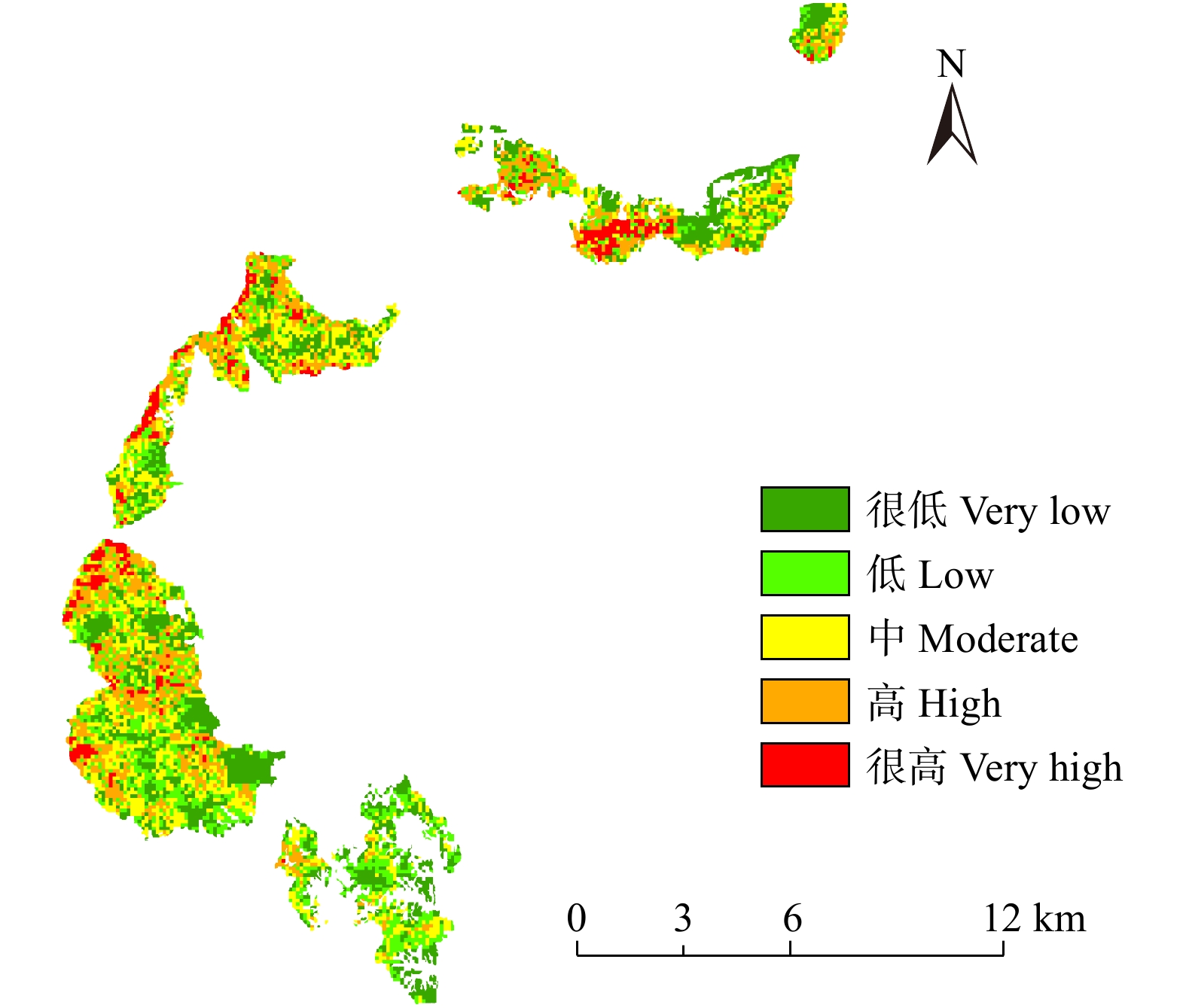Quantitative assessment for forest fire risk based on fire simulation: taking the Subtropical Forest Experimental Center of Chinese Academy of Forestry as an example
-
摘要:目的 森林火灾风险评估是利用定量或定性的方法综合考虑一个区域的火发生可能性及对环境造成的潜在影响,识别区域内的高火灾风险区是开展科学林火管理的基础。本研究基于森林燃烧概率、潜在火行为和暴露性综合评估一个区域的森林火灾风险,为林火管理部门开展林火管理和可燃物处理提供指导。方法 利用燃烧概率模型(Burn-P3)在景观尺度上模拟亚热带林业实验中心所属林区的燃烧概率、潜在火强度、蔓延速度及火发生类型。根据火对周围城镇和水源的潜在环境和安全问题计算火灾暴露性。综合这些指标利用层次分析方法定量评估森林火灾风险,分析火灾风险的空间特征和不同类型植被的燃烧性差异。结果 火模拟结果表明:研究区的平均燃烧概率为0.040 1,燃烧概率高和很高的区域分别占研究区的5.3%和2.3%。火烧以地表火和间歇性树冠火为主,平均火强度及蔓延速度分别为2 043.6 kW/m2和2.5 m/min。火行为指数高和很高的区域分别占17.3%和6.2%。针阔混交林的燃烧概率和潜在火行为指数最高,阔叶林的燃烧概率及潜在火行为指数最低,但其暴露性指数最高。火灾风险综合评估结果表明,风险高和很高的区域分别占19.7%和6.5%,针阔混交林的火灾风险指数高于其他植被类型。结论 研究区内大部分区域的燃烧概率较低,但潜在火行为指数较高。城镇和水源附近森林的火灾风险等级高,是林火管理的重点区域。部分针叶林和针阔混交林存在发生稳进树冠火的可能,可以通过可燃物处理措施来减少可燃物梯及地表易燃可燃物,降低火灾风险。Abstract:Objective Forest fire risk assessment is to describe the potential occurrence of forest fire and the direct or indirect fire impacts on environment at the landscape scale by qualitative and/or quantitative indicators. Identifying the areas with high fire risk is the base of forest fire management. Comprehensive assessment on forest fire risk for a region based on burn probability, potential fire behavior, and exposure provides a guide for local fire agency to carry out fire and fuel management.Method We simulated the burn probability, potential fire intensity, spreading speed, and fire types on the landscape scale for the forests in the Subtropical Forestry Experimental Center by the burn probability model (Burn-P3). The potential fire impacts on surrounding communities and water sources were analyzed for exposure. We also analyzed the spatial characteristics of fire risk, burn probability, and potential fire behavior of every vegetation type. A comprehensive assessment model on fire risk was constructed by analytic hierarchy process.Result The fire simulation results showed that the average burn probability of the study area was 0.040 1, and the areas with high and very high burn probability accounted for 5.3% and 2.3%, respectively. The fire types were mainly surface fire and intermittent crown fire. The average fire intensity and spread speed were 2 043.6 kW/m2 and 2.5 m/min, respectively. The areas with high and very high fire behavior index accounted for 17.3% and 6.2% of the total areas, respectively. The coniferous and broadleaved mixed forest had the highest rating on burn probability and potential fire behavior index. The broadleaved forest had the lowest grade on burn probability and fire behavior index, but showed the highest exposure. The comprehensive assessment results on fire risk showed that the areas with high and very high risk accounted for 19.7% and 6.5%, respectively. The fire risk of coniferous and broadleaved mixed forest was higher than that of the other vegetation types.Conclusion Most of the study area has low burn probability and high potential fire behavior index. The forests near towns and water sources show high fire risks, which should be the key areas for fire management in the future. It is necessary to carry out fuel cleaning measures to reduce fuel ladder and surface inflammable fuels in coniferous forest and coniferous and broadleaved mixed forest in order to reduce their fire risk.
-
Keywords:
- forest fire /
- burn probability /
- fire behavior /
- risk assessment /
- fire simulation
-
樟子松(Pinus sylvestris var. mongolica)隶属于松科(Pinaceae)松属(Pinus),是欧洲赤松(P. sylvestris)的一个变种,该树种抗旱、耐寒、耐瘠薄、防风固沙、适应性强,能够在降水量低、土壤贫瘠的沙土上顽强生长,是我国北方干旱和半干旱沙区防风固沙和水土保持的重要树种[1-4]。自1964年樟子松在陕西榆林红石峡引种栽培成功后[5],经过几十年的推广造林,已成为毛乌素沙区防风固沙造林的常用树种,对陕北沙区生态环境的改善发挥了重要作用[6-8]。营建樟子松种子园的主要目的是为造林绿化和林业生产提供遗传和品质优良的种子[6],随着樟子松母树年龄和树体高度的增加,采种难度也随之增加,树冠中上部的优质种子难以采收,导致种子质量参差不齐,严重影响了种子的产量和质量[9-10]。因此,矮化樟子松母树已成为沙区樟子松种子园亟待解决的技术问题之一,对种子园母树优质高产和科学管理具有重要意义。
关于种子园母树矮化和结实方面的研究,国内外已有大量报道。地中海白松(P. halepensis)[11]、欧洲赤松[12]、火炬松(P. taeda)[13]、辐射松(P. radiate)[14-16]、红松(P. koraiensis)[17-18]、油松(P. tabulaeformis)[19]、长白落叶松(Larix olgensis)[20]、杏仁桉(Eucalyptus regnans)[21]经过修剪、摘心、截冠等矮化处理后,结实量和种子品质均有所提高。洪永辉等[22-23]和谭小梅等[24]对马尾松二代种子园内的61个无性系母树进行截干处理,发现马尾松母树经过处理后分枝角变大,枝下高降低,冠幅增加,侧枝结果率、球果产量和籽粒质量均提高,采种成本大幅度下降。黄开勇等[25]对杉木种子园大龄母树进行截杆矮化处理,发现大多数杉木无性系母树截杆处理后种子产量明显提高,种子质量明显改善。戴俊等[26]研究发现杉木种子园内经截杆处理后的大部分无性系母树种子的发芽率、发芽势和发芽指数明显提高,且用其种子繁殖的子代苗木地径和苗高均显著高于未截杆处理母树种子繁殖的子代苗木。
目前关于樟子松矮化处理方面的研究报道相对较少。王曼[27]研究发现对老龄樟子松母树进行疏枝、截顶、截轮枝3种修剪措施后,樟子松母树结实量下降;王福森等[10]研究发现幼龄樟子松母树截冠矮化处理后,樟子松母树的单果质量和单株结实量分别提高了46.7%和95.5%,种子的质量增加了107%,发芽率和发芽势分别提高了8.1%和3.1%。截冠处理对樟子松壮龄母树结实方面的影响尚未见报道。本试验以榆林市樟子松种子园的壮龄母树为研究对象,对其进行截冠处理,并以相同系号的未截冠樟子松母树作为对照,研究截冠前后球果产量、球果大小、种子产量及质量指标的变化情况,揭示截冠处理对樟子松壮龄母树结实的影响,探索樟子松壮龄母树管理的关键技术,为樟子松种子园壮龄母树的优质高产和科学管理提供基础资料。
1. 材料方法
1.1 试验地概况
研究区设在陕西省榆林市樟子松种子园(109°46′02″ ~ 109°46′30″E、38°09′06″ ~ 38°09′27″N),位于榆林市城南约15.2 km处,地处毛乌素沙地南缘与黄土丘陵区过渡地带,平均海拔1 024 m。该种子园为西北地区最大的樟子松种子园,属温带半干旱大陆性季风气候,园内年平均气温8.1 ~ 10.7 ℃,极端低温− 32.7 ℃,极端高温38.6 ℃,年平均降水量432 mm,降水主要集中于7—9月,蒸发量大于1 900 mm,年平均风速5.1 m/s,最大风速为28.1 m/s。土壤为沙土和盖沙黄土,通透性好,有机质含量低,为0.32% ~ 0.54%,pH值为6.9 ~ 7.6。研究样地内主要植物有角茴香(Hypecoum erectum)、虎尾草(Chloris virgata)、角蒿(Incarvillea sinensis)、沙打旺(Astragalus adsurgens)、醉马草(Achnatherum inebrians)、冰草(Agropyron cristatum)。目前樟子松种子园内有68个无性系母树,主要源自内蒙古红花尔基天然樟子松林和榆林当地。研究区域内有18个樟子松无性系,树龄均为24年,平均胸径17.16 cm,平均冠幅4.69 m,定植密度5.0 m × 5.0 m。
1.2 试验方法
2016年3月8日至3月11日,对研究区内的18个樟子松无性系母树,按照冠幅不超过10 cm、树高不超过20 cm和胸径不超过1.5 cm的标准,每个无性系挑选出6株樟子松母树用于试验,每个无性系随机选取3株母树进行截冠处理,截去顶部3轮枝,余下的轮枝在每枝距离树干2/3处进行拉枝垂吊处理,并以相同无性系未截冠母树作为对照,截冠处理与未截冠处理的母树均采用相同的抚育管理措施,每年进行正常的施肥和人工除草各1次。
2018年11月15日至20日,对樟子松母树所有球果进行采摘,分别装袋标记。对截冠处理和对照组樟子松的单果质量、单株球果质量、单株种子质量、出籽率、球果的长径和短径、种子千粒质量和优良度8个指标进行测定分析,以此研究截冠处理对樟子松壮龄母树结实的影响。
1.3 数据分析
数据采用Excel 2016和DPS 17.1软件进行处理。对截冠处理母树和未截冠处理母树的各项指标进行统计分析,出籽率(SY)、截冠处理母树各指标相对于未截冠处理母树单个无性系的增益值(Gn)及平均增益值(GA)按照如下公式计算。
SY=P/C×100%, (1) 式中:P为单株种子质量,C为单株球果质量。
Gn=(An−Bn)/Bn×100% (2) 式中:An是第n个无性系樟子松母树截冠处理的指标测定值,Bn为第n号无性系母树未截冠处理的指标测定值。
GA=(G1+G2+G3+⋅⋅⋅Gn)/n×100% (3) 式中:G1、G2、G3、···Gn代表第1、2、3···n个无性系的增益值,n为无性系数量。
采用两配对样本t检验法对单果质量、单株球果质量、单株种子质量、出籽率4个产量指标在截冠处理与对照之间的差异进行分析。
2. 结果与分析
2.1 截冠处理对樟子松壮龄母树球果和种子产量的影响
以截冠处理的18个无性系樟子松母树作为一个样本,以未截冠相对应系号樟子松母树作为另一个样本,进行配对t检验,截冠处理母树与未截冠母树各产量指标的t检验结果见表1。从表1可知,截冠处理母树与未截冠处理母树的单果质量和单株球果质量2个产量指标没有显著性差异(P > 0.05),说明截冠处理对单果质量和单株球果质量影响不显著。樟子松母树的单株种子质量和出籽率在截冠处理与对照之间存在显著差异(P < 0.05),说明截冠处理对种子产量具有显著影响。
表 1 截冠处理母树与未截冠母树各产量指标的配对t检验结果Table 1. Comparing sample t-test results on yield index of mother trees under top pruning and non-top pruning产量指标 Yield index 均值 Mean 标准差 Standard deviation t值 t value 自由度 df P值 P value 单果质量 Single cone mass − 1.022 5.286 0.820 17 0.423 3 单株球果质量 Cone mass per tree − 43.41 688.228 0.268 17 0.792 2 单株种子质量 Seed mass per tree − 5.448 10.492 2.203 17 0.041 7 出籽率 Seed-production rate − 0.408 0.595 2.910 17 0.009 8 2.2 截冠处理对樟子松壮龄母树球果产量的增益分析
截冠处理对樟子松壮龄母树的球果产量增益分析见表2。截冠处理后樟子松母树无性系单果质量增益值在− 62.41% ~ 235.04%之间,平均增益值为24.86%。其中10个无性系母树单果质量为正增益(1、6、28、47、29、13、60、46、34、21),其余8个无性系母树单果质量为负增益。樟子松壮龄母树无性系单株球果质量的增益值在− 61.82% ~ 189.47%之间,平均增益值为23.82%。7个无性系母树单株球果质量为正增益(1、6、47、29、60、34、21),11个无性系母树单株球果质量为负增益。从平均增益值来看,截冠后樟子松壮龄母树球果产量呈增长状态,说明截冠在一定程度上能提高樟子松壮龄母树球果产量。
表 2 截冠处理对樟子松壮龄母树的球果产量增益分析Table 2. Gain analysis on cone yield of aged Pinus sylvestris var. mongolica mother trees after top pruning无性系号
Clone No.对照
CK截冠处理
Top pruning treatment单个无性系截冠后球果产量增益值
Gain value of cone yield of single clone after top pruning/%单果质量
Single cone mass/g单株球果质量
Cone mass per tree/g单果质量
Single cone mass/g单株球果质量
Cone mass per tree/g单果质量
Single cone mass单株球果质量
Cone mass per tree51 9.16 541.43 7.88 533.10 − 13.97 − 1.54 11 7.13 374.93 4.53 281.21 − 36.47 − 25.00 5 7.99 1 140.72 7.24 733.75 − 9.39 − 35.68 7 9.28 1 608.56 7.22 1 265.94 − 22.20 − 21.30 1 6.45 1 308.45 21.61 3 527.86 235.04 169.62 53 11.14 1 412.40 7.36 539.27 − 33.93 − 61.82 6 6.09 634.09 9.63 1 085.75 58.13 71.23 28 5.49 693.81 6.31 639.31 14.94 − 7.86 47 5.92 190.58 15.72 456.31 165.54 139.43 29 6.5 1 473.43 10.10 1 750.91 55.38 18.83 13 9.61 1 680.89 11.03 1 659.67 14.78 − 1.26 38 8.61 1 728.75 6.68 1 198.34 − 22.42 − 30.68 60 5.21 585.68 9.10 1 275.45 74.66 117.77 46 6.23 1 508.47 6.32 1 039.56 1.44 − 31.09 30 13.54 1 301.56 5.09 761.10 − 62.41 − 41.52 40 8.29 1 002.52 4.80 526.41 − 42.10 − 47.49 34 9.00 1 560.54 11.47 1 993.02 27.44 27.71 21 4.54 137.91 6.49 399.21 42.95 189.47 平均增益值
Average gain value/ / / / 24.86 23.82 注:“/”代表此项内容不存在。下同。Notes:“/” represents this content non-existents.The same below. 2.3 截冠处理对樟子松壮龄母树种子产量的增益分析
截冠处理对樟子松壮龄母树种子产量的增益分析见表3。截冠处理后樟子松单株种子质量的增益值在− 65.94% ~ 273.26%之间,其中仅有3个樟子松无性系单株种子质量为负增益(28、38、53),其余15个无性系为正增益。种子出籽率也出现了类似的结果,樟子松种子出籽率的增益值在− 39.33% ~191.38%之间,5个无性系母树种子出籽率为负增益(1、30、38、53、60),其余13个无性系为正增益。单株种子质量的平均增益值是81.38%,出籽率的平均增益值是55.94%,说明截冠处理能提高樟子松壮龄母树种子产量。
表 3 截冠处理对樟子松壮龄母树种子产量增益分析Table 3. Gain analysis on seed yield of aged Pinus sylvestris var. mongolica mother trees after top pruning无性系号
Clone No.对照
CK截冠处理
Top pruning treatment单个无性系截冠后种子产量增益值
Gain value of seed yield of single clone after top pruning/%单株种子质量
Seed mass per tree/g出籽率
Seed-production rate/%单株种子质量
Seed mass per tree/g出籽率
Seed-production rate/%单株种子质量
Seed mass per tree出籽率
Seed-production
rate51 5.11 0.94 10.88 2.04 112.92 117.02 11 3.80 1.01 13.14 1.12 245.79 10.89 5 9.19 0.81 16.85 2.30 83.35 183.95 7 22.36 1.39 22.42 1.77 0.27 27.34 1 13.05 1.00 30.61 0.87 134.56 − 13.00 53 15.21 1.08 5.18 0.96 − 65.94 − 11.11 6 4.86 0.77 16.31 1.5 235.6 94.81 28 11.66 1.68 11.04 1.73 − 5.32 2.98 47 4.77 0.6 7.97 1.09 67.09 81.67 29 20.19 1.37 29.48 1.68 46.01 22.63 13 21.36 1.27 33.17 2.00 55.29 57.48 38 41.35 2.39 17.43 1.45 − 57.85 − 39.33 60 8.34 1.42 14.93 1.17 79.02 − 17.61 46 17.26 1.14 19.63 1.89 13.73 65.79 30 16.08 1.24 19.35 1.23 20.34 − 0.81 40 12.98 1.29 19.96 1.89 53.78 46.51 34 9.05 0.58 33.78 1.69 273.26 191.38 21 7.26 0.51 19.82 1.46 173.00 186.27 平均增益值
Average gain value/%/ / / / 81.38 55.94 2.4 截冠处理对樟子松壮龄母树球果大小的影响
截冠处理对樟子松壮龄母树球果大小的影响见表4。从增益值分析可知,截冠后樟子松壮龄母树球果的平均短径增益值在− 29.36% ~ 42.23%之间,平均增益值为− 0.25%,其中有11个无性系为正增益,7个无性系为负增益。截冠后樟子松壮龄母树球果的平均长径增益值在− 31.59% ~ 43.31%之间,平均增益值为1.37%,其中有7个无性系为正增益,11个无性系为负增益。表5为截冠处理与未截冠处理母树的球果大小指标的配对t检验结果,不难看出,截冠处理与对照母树的球果长径和球果短径均无显著差异(P > 0.05),说明截冠对樟子松壮龄母树球果大小的影响不显著。
表 4 截冠处理对樟子松壮龄母树球果大小的影响Table 4. Effects of top pruning on cone size of aged Pinus sylvestris var. mongolica mother trees无性系号
Clone No.对照
CK截冠处理
Top pruning treatment单个无性系截冠后球果大小增益值
Gain value of cone size of single clone after top pruning/%球果短径
Cone short diameter/mm球果长径
Cone long diameter/mm球果短径
Cone short diameter/mm球果长径
Cone long diameter/mm球果短径
Cone short
diameter球果长径
Cone long
diameter51 19.17 ± 0.30 45.77 ± 1.72 19.81 ± 0.39 42.22 ± 1.43 3.34 -7.75 11 18.51 ± 0.16 40.21 ± 1.20 16.10 ± 0.75 35.78 ± 0.30 − 13.00 − 11.02 5 18.69 ± 0.57 42.66 ± 1.42 19.07 ± 0.45 35.84 ± 2.37 2.05 − 15.99 7 20.37 ± 0.62 45.18 ± 1.21 18.44 ± 0.14 43.86 ± 2.65 − 9.46 − 2.92 1 18.51 ± 0.55 35.45 ± 1.23 20.60 ± 0.07 38.31 ± 1.33 11.29 8.07 53 17.34 ± 0.67 47.49 ± 0.12 18.43 ± 0.50 40.58 ± 0.95 6.29 − 14.54 6 20.60 ± 0.07 38.13 ± 1.33 19.73 ± 0.27 45.19 ± 1.61 − 4.22 18.52 28 21.18 ± 0.47 31.94 ± 2.21 17.61 ± 0.22 35.92 ± 1.59 − 16.86 12.45 47 16.28 ± 0.61 40.08 ± 3.85 23.16 ± 0.41 57.44 ± 1.23 42.23 43.31 29 19.02 ± 0.20 35.32 ± 1.49 20.11 ± 0.98 40.80 ± 1.04 5.73 15.53 13 21.91 ± 0.44 43.40 ± 2.69 22.49 ± 0.73 36.11 ± 2.86 2.65 − 16.8 38 23.91 ± 0.46 40.94 ± 1.51 16.89 ± 0.28 34.57 ± 1.73 − 29.36 − 15.56 60 16.58 ± 0.70 29.48 ± 3.56 19.36 ± 0.30 41.77 ± 2.52 16.74 41.71 46 17.33 ± 0.41 40.45 ± 2.75 17.68 ± 0.51 37.08 ± 1.31 2.02 − 8.34 30 16.58 ± 1.21 51.69 ± 2.73 17.66 ± 0.43 35.36 ± 2.29 6.51 − 31.59 40 20.65 ± 0.17 36.50 ± 1.99 16.14 ± 0.88 35.50 ± 0.86 − 21.83 − 2.74 34 20.68 ± 0.29 42.58 ± 1.81 22.60 ± 0.48 52.22 ± 1.77 9.27 22.64 21 21.94 ± 0.39 33.54 ± 2.12 18.01 ± 0.30 32.80 ± 0.50 − 17.9 − 2.22 平均增益值
Average gain value/ / / / − 0.25 1.37 表 5 截冠处理母树与未截冠母树球果大小指标的配对t检验结果Table 5. Comparing sample t-test results on cone size index of mother trees under top pruning and non-top pruning球果大小指标 Cone size index 均值 Mean 标准差 Standard deviation t值 t value 自由度 df P值 P value 球果短径 Cone short diameter 0.297 8 3.201 0.395 17 0.698 0 球果长径 Cone long diameter − 0.030 0 8.227 0.016 17 0.987 8 2.5 截冠处理对樟子松壮龄母树种子质量的影响
截冠处理对樟子松壮龄母树种子质量的影响见表6,对增益值进行分析可知,樟子松母树无性系截冠后种子千粒质量增益值范围为− 41.8% ~ 68.60%,平均增益值为7.43%,其中仅有6个负增益(5、7、11、28、38、51),其余12个都为正增益;单个无性系截冠后种子优良度增益值为6.25% ~ 45.00%之间,平均增益值为24.96%,且优良度增益全为正增益。截冠处理母树与未截冠母树的种子质量指标的配对t检验结果(见表7),截冠处理母树与对照母树种子千粒质量无显著差异(P > 0.05),截冠处理与对照母树种子优良度有显著差异(P < 0.05),截冠处理对种子千粒质量无明显影响,对种子优良度有明显影响。说明截冠处理可以提高樟子松母树种子质量。
表 6 截冠处理对樟子松壮龄母树种子质量的影响Table 6. Effects of top pruning on seed quality of aged Pinus sylvestris var. mongolica mother trees无性系号
Clone No.对照
CK截冠处理
Top pruning treatment单个无性系截冠后种子质量增益值
Gain value of seed quality of single clone after top pruning/%种子千粒质量
Thousand seed mass/g优良度
Seed soundness /%种子千粒质量
Thousand seed mass/g优良度
Seed soundness/%种子千粒质量
Thousand seed
mass优良度
Seed soundness51 10.48 ± 0.02 45 ± 1.28 8.72 ± 0.02 54 ± 1.56 − 16.79 20.00 11 9.45 ± 0.07 48 ± 1.35 7.95 ± 0.04 55 ± 1.78 − 15.87 14.58 5 7.89 ± 0.04 55 ± 1.02 7.04 ± 0.04 62 ± 1.87 − 10.77 12.73 7 8.36 ± 0.06 54 ± 1.32 6.11 ± 0.07 67 ± 1.71 − 26.91 24.07 1 9.10 ± 0.08 44 ± 1.09 13.2 ± 0.03 57 ± 2.43 45.05 29.55 53 7.04 ± 0.08 49 ± 1.43 9.57 ± 0.01 62 ± 2.10 35.94 26.53 6 7.42 ± 0.06 55 ± 1.52 8.50 ± 0.04 61 ± 1.37 14.56 10.91 28 7.56 ± 0.13 47 ± 1.76 4.40 ± 0.04 57 ± 1.56 − 41.80 21.28 47 7.62 ± 0.05 38 ± 1.24 9.86 ± 0.01 53 ± 1.62 29.40 39.47 29 5.86 ± 0.06 40 ± 1.31 9.88 ± 0.02 58 ± 2.02 68.60 45.00 13 8.83 ± 0.03 51 ± 1.27 11.13 ± 0.03 61 ± 1.74 26.05 19.61 38 9.73 ± 0.03 48 ± 1.42 7.39 ± 0.06 51 ± 2.48 − 24.05 6.25 60 7.18 ± 0.08 38 ± 1.24 7.90 ± 0.03 50 ± 1.91 10.03 31.58 46 8.85 ± 0.11 41 ± 1.44 8.96 ± 0.02 53 ± 2.13 1.24 29.27 30 7.96 ± 0.03 39 ± 1.09 8.03 ± 0.02 53 ± 1.53 0.88 35.90 40 7.75 ± 0.03 53 ± 1.53 8.86 ± 0.01 59 ± 1.41 14.32 11.32 34 6.41 ± 0.06 47 ± 1.43 7.69 ± 0.04 66 ± 2.66 19.97 40.43 21 7.84 ± 0.03 52 ± 1.47 8.15 ± 0.03 68 ± 1.73 3.95 30.77 平均增益值
Average gain value/ / / / 7.43 24.96 表 7 截冠处理与未截冠母树种子质量指标的配对t检验结果Table 7. Comparing sample t-test results on seed quality index of mother trees under top pruning and non-top pruning种子质量指标 Seed quality index 均值 Mean 标准差 Standard deviation t值 t value 自由度 df P值 P value 种子千粒质量 Thousand seed mass − 0.445 2.133 0.885 17 0.388 5 种子优良度 Seed soundness − 11.278 4.390 10.900 17 0.000 1 3. 讨 论
樟子松无性系种子园母树的矮化技术,既能降低樟子松母树结实高度便于球果采集,又能促进樟子松结实和提高种子的产量和质量,近年来成为种子园母树科学经营管理的研究热点[10,28-29]。本研究对樟子松种子园18个无性系壮龄母树进行截冠处理,发现截冠处理母树和未截冠处理母树的单果质量和单株球果质量的统计学未达到显著水平,但二者的增益值分别达24.84%和23.82%,说明截冠在一定程度上能提高樟子松壮龄母树球果产量;这和辐射松[14]、油松[19]、大龄杉木[25]的研究结果一致。本研究发现,樟子松壮龄母树截冠处理后单株种子质量和种子出籽率明显提高,平均增益值分别达81.38%、55.94%,配对t检验显示差异显著,说明截冠处理对种子产量有明显促进作用。这和幼龄樟子松[10]、红松[18]、油松[19]、大龄杉木[25]、马尾松[30]的研究结果一致。一般来说,截冠处理消除了顶端优势,营养物质向母树中下部运输,同时冠幅增加,通风透光条件得到改善,树势增强,从而提高了母树的产量。
目前关于樟子松矮化处理和种子结实方面的研究报道不多。王福森等[10]研究发现截冠处理后樟子松母树的单果质量增加了46.7%,单株结实量增加了95.5%,种子产量增加了1.07倍。本研究发现截冠处理后樟子松母树的单果质量、单株结实量和种子的产量增加值均低于王福森等[10]的研究结果。原因可能是前者的试验研究区位于黑龙江省龙江县错海林场,降水量相对较高、蒸发量相对低;而本研究的试验区域位于毛乌素沙地,降雨量少、蒸发量大[31],生长环境较前者相对恶劣;另一个原因可能是,前者在幼龄期对樟子松母树进行截冠处理,而本研究是壮龄期对樟子松母树进行截冠处理,幼龄樟子松的恢复能力比壮龄樟子松的恢复能力强。这和王玉光等[18]的研究结果一致,即红松母树在幼龄截干矮化后结实量比在壮龄期截干矮化结实量大。本研究发现截冠处理后12个无性系母树种子千粒质量增加,全部无性系母树种子优良度提高,说明截冠处理能明显提高樟子松母树的种子优良度和种子质量。这和王福森等[10]对幼龄樟子松母树的研究结果一致。
截冠处理对松科和杉科(Taxodiaceae)树种球果大小的影响的研究报道较少。谭小梅等[24]研究发现马尾松经截冠处理后球果的长径和短径分别增加了8.02%和7.44%。黄开勇等[25]研究发现,截冠处理对杉木球果大小有一定影响,对球果长径和球果短径在同一无性系之间影响一致。本研究发现,截冠处理对樟子松母树球果大小也有一定的影响,但对球果长径和球果短径在同一无性系之间影响不一致。分析原因可能是不同树种的生物学特性导致的差异,或者是截冠处理影响了球果长径和短径的变化,具体原因需进一步研究。
樟子松壮龄母树截干后单果质量、单株球果质量、单株种子质量、出籽率和种子千粒质量5个指标,在不同无性系之间差异较大,不同指标间规律性不强,原因可能是樟子松不同无性系截冠处理后表现不同,也可能是截冠处理选择样本的重复数过少造成的,具体原因尚需进一步探索。本研究还发现7个无性系(1、6、21、28、34、47、60)母树的单果质量和单株球果质量增益值均为正值,8个无性系(5、7、11、28、30、40、51、53)母树的单果质量和单株球果质量增益值均为负值。在今后的研究中,根据本试验的研究结果分别对截冠处理后单果质量和单株球果质量增益值为正值和负值的母树进行挑选,重新配置样地,然后进行截冠处理,同时增加无性系母树的重复株数,以此得到更为科学客观的结果。
值得一提的是,对于樟子松种子园壮龄母树来说,经过多次截冠处理来降低母树高度,不一定符合生产实际,主要原因是多次截干处理会造成樟子松树势衰弱,病虫害频发等问题[6,10],此外也增加了成本。在实际的樟子松种子园经营管理中,最好的方法是对壮龄母树一次截冠使其降低到合理高度,且截冠处理以后要对樟子松母树进行科学和精心的管护。因此,樟子松母树截冠处理后,对其进行4个方向的拉枝垂吊处理,改变枝条的生长方向,缓和枝条长势,建立良好的冠形结构。这样处理会增加樟子松母树的空间利用率,改善母树的光照条件,增加樟子松对病虫害的抵抗能力,也可以促进花芽分化,增加有效结实部位,同时促进营养物质在树体合理分配,提高结实的产量和种子质量。
4. 结 论
对种子园18个无性系樟子松壮龄母树进行截冠处理,对比分析截冠处理和未截冠处理对樟子松壮龄母树球果产量、种子产量、球果大小及种子质量的影响,主要结论如下:
(1)截冠处理对母树单果质量和单株球果质量2个指标影响不显著,其平均增益值分别达24.84%和23.82%;说明截冠处理在一定程度上能提高樟子松壮龄母树球果产量。截冠处理对母树单株种子质量和种子出籽率有明显影响,说明截冠处理能明显提高樟子松壮龄母树种子产量。截冠处理对球果长和短径均无明显影响,截冠处理对樟子松壮龄母树球果大小影响不显著。
(2)截冠处理后大部分无性系母树种子千粒质量为正增益,全部无性系母树种子优良度为正增益。说明截冠处理可以提高樟子松壮龄母树种子质量。总之,本研究证明截冠可以提高樟子松壮龄母树产量和种子质量。
-
图 2 Burn-P3模型输入的可燃物类型和DEM数据
C-5.成熟的常绿针叶林;D-1/D-2.常绿及落叶阔叶林混交;M-2.由80%常绿针叶林和20%阔叶林组成的混交林。C-5, the mature evergreen coniferous forest, D-1/D-2, mixed stands with evergreen and deciduous broadleaved trees. M-2, mixed stands with 80% evergreen coniferous trees and 20% broadleaved trees.
Figure 2. Inputs of fuel types and DEM for Burn-P3 model
表 1 燃烧概率及火行为赋值
Table 1 Assignments for burn probability and fire behavior
燃烧概率 Burn probability 火强度 Fire intensity 蔓延速度 Spread speed 火类型 Fire type 赋值 Score 很低 Very low 很低 Very low 很低 Very low 地表火 Surface fire 1 低 Low 低 Low 低 Low 3 中 Moderate 中 Moderate 中 Moderate 间歇性树冠火 Intermittent crown fire 5 高 High 高 High 高 High 7 很高 Very high 很高 Very high 很高 Very high 稳进树冠火 Continuous crown fire 9 表 2 森林火险评估指标的权重
Table 2 Weight of the indexes for forest fire risk assessment
B层指数
Index in B layerB层权重
Weight of index
in B layerC层指标
Index in C layerC层相对B层权重
Weight of index in
C layer to B layerC层相对目标层权重
Weight of index in
C layer to target layer火发生可能
Burn probability0.5 燃烧概率
Burn probability1.00 0.50 火行为
Fire behavior0.4 火强度
Fire intensity0.36 0.15 蔓延速度
Rate of spread0.18 0.07 火类型
Fire type0.46 0.18 暴露性
Exposure0.1 距城镇距离
Distance to towns0.63 0.06 距水体距离
Distance to water0.37 0.04 表 3 各植被类型的火灾风险值
Table 3 Fire risk indexes of every forest type
林型 Forest type 燃烧概率
Burn probability火行为
Fire behavior暴露性
Exposure火险风险指数
Fire risk index针阔混交林 Coniferous and broadleaved mixed forest 0.369 0 0.320 3 0.405 4 0.354 5 常绿针叶林 Evergreen coniferous forest 0.114 2 0.006 1 0.432 5 0.103 0 阔叶林 Broadleaved forest 0.040 2 0.000 1 0.440 5 0.064 5 -
[1] Chuvieco E, Aguado I, Yebra M, et al. Development of a framework for fire risk assessment using remote sensing and geographic information system technologies[J]. Ecological Modelling, 2010, 221(1): 46−58. doi: 10.1016/j.ecolmodel.2008.11.017
[2] Johnston L M, Wang X, Erni S, et al. Wildland fire risk research in Canada[J]. Environmental Reviews, 2020, 28(2): 1−23.
[3] 郑忠, 高阳华, 杨庆媛, 等. 西南山地区域森林火险综合预报模型研究: 以重庆市为例[J]. 自然灾害学报, 2020, 29(1): 152−161. Zheng Z, Gao Y H, Yang Q Y, et al. Research on the construction of composite risk prediction model for forest fire in the mountainous area of southwestern China: taking Chongqing City as an example[J]. Journal of Natural Disasters, 2020, 29(1): 152−161.
[4] United Nations Office for Disaster Risk Reduction. Words into action guidelines: national disaster risk assessment hazard specific risk assessment[R]. New York: United Nations Office for Disaster Risk Reduction, 2017.
[5] Calkin D E, Cohen J D, Finney M A, et al. How risk management can prevent future wildfire disasters in the wildland-urban interface[J]. Proceedings of the National Academy of Sciences, 2014, 111(2): 746−751. doi: 10.1073/pnas.1315088111
[6] Chuvieco E, Aguado I, Jurdao S, et al. Integrating geospatial information into fire risk assessment[J]. International Journal of Wildland Fire, 2014, 23(5): 606−619. doi: 10.1071/WF12052
[7] 田晓瑞, 代玄, 王明玉, 等. 多气候情景下中国森林火灾风险评估[J]. 应用生态学报, 2016, 27(3): 769−776. Tian X R, Dai X, Wang M Y, et al. Forest fire risk assessment for China under different climate scenarios[J]. Chinese Journal of Applied Ecology, 2016, 27(3): 769−776.
[8] Woo H, Chung W, Graham J M, et al. Forest fire risk assessment using point process modelling of fire occurrence and Monte Carlo fire simulation[J]. International Journal of Wildland Fire, 2017, 26(9): 789−805. doi: 10.1071/WF17021
[9] Molaudzi O D, Adelabu S A. Review of the use of remote sensing for monitoring wildfire risk conditions to support fire risk assessment in protected areas[J]. South African Journal of Geomatics, 2019, 7(3): 222−242. doi: 10.4314/sajg.v7i3.2
[10] 颜峻, 左哲. 自然灾害风险评估指标体系及方法研究[J]. 中国安全科学学报, 2010, 20(11): 61−65. doi: 10.3969/j.issn.1003-3033.2010.11.011 Yan J, Zuo Z. Research on natural disaster risk assessment index system and method[J]. China Safety Science Journal, 2010, 20(11): 61−65. doi: 10.3969/j.issn.1003-3033.2010.11.011
[11] You W, Lin L, Wu L, et al. Geographical information system-based forest fire risk assessment integrating national forest inventory data and analysis of its spatiotemporal variability[J]. Ecological Indicators, 2017, 77: 176−184. doi: 10.1016/j.ecolind.2017.01.042
[12] Thompson M P, Calkin D E, Finney M A, et al. A risk-based approach to wildland fire budgetary planning[J]. Forest Science, 2013, 59(1): 63−77. doi: 10.5849/forsci.09-124
[13] Alcasena F J, Salis M, Ager A A, et al. Assessing landscape scale wildfire exposure for highly valued resources in a Mediterranean area[J]. Environmental Management, 2015, 55(5): 1200−1216. doi: 10.1007/s00267-015-0448-6
[14] Xi D D Z, Taylor S W, Woolford D G, et al. Statistical models of key components of wildfire risk[J]. Annual Review of Statistics and Its Application, 2017, 6(1): 1−26.
[15] Kanga S, Sharma L K, Pandey P C, et al. Forest fire modeling to evaluate potential hazard to tourism sites using geospatial approach[J]. Journal of Geomatics, 2013, 7(1): 93−99.
[16] Ajin R S, Ciobotaru A, Vinod P G, et al. Forest and wildland fire risk assessment using geospatial techniques: a case study of Nemmara forest division, Kerala, India[J]. Journal of Wetlands Biodiversity, 2015, 5: 29−37.
[17] Thompson M P, Freeborn P, Rieck J D, et al. Quantifying the influence of previously burned areas on suppression effectiveness and avoided exposure: a case study of the Las Conchas Fire[J]. International Journal of Wildland Fire, 2016, 25(2): 167−181. doi: 10.1071/WF14216
[18] Ager A A, Preisler H K, Arca B, et al. Wildfire risk estimation in the Mediterranean area[J]. Environmetrics, 2014, 25(6): 384−396. doi: 10.1002/env.2269
[19] Mitsopoulos I, Trapatsas P, Xanthopoulos G. SYPYDA: a software tool for fire management in Mediterranean pine forests of Greece[J]. Computers and Electronics in Agriculture, 2016, 121: 195−199. doi: 10.1016/j.compag.2015.12.011
[20] Noonan-Wright E K, Opperman T S, Finney M A, et al. Developing the US wildland fire decision support system[J]. Journal of Combustion, 2011, 2011: 1−14.
[21] Massada A B, Radeloff V C, Stewart S I, et al. Wildfire risk in the wildland-urban interface: a simulation study in northwestern Wisconsin[J]. Forest Ecology and Management, 2009, 258(9): 1990−1999. doi: 10.1016/j.foreco.2009.07.051
[22] Beverly J L, Mcloughlin N. Burn probability simulation and subsequent wildland fire activity in Alberta, Canada: implications for risk assessment and strategic planning: reply to Parisien et al. [J/OL]. Forest Ecology and Management, 2020, 460: 117819[2021−05−19]. https://doi.org/10.1016/j.foreco.2019.117819.
[23] Carmel Y, Paz S, Jahashan F, et al. Assessing fire risk using Monte Carlo simulations of fire spread[J]. Forest Ecology and Management, 2009, 257(1): 370−377. doi: 10.1016/j.foreco.2008.09.039
[24] Oban H O, Erdin C. Forest fire risk assessment using GIS and AHP integration in Bucak forest enterprise, Turkey[J]. Applied Ecology and Environmental Research, 2020, 18(1): 1567−1583. doi: 10.15666/aeer/1801_15671583
[25] Mhawej M, Faour G, Abdallah C, et al. Towards an establishment of a wildfire risk system in a Mediterranean country[J]. Ecological Informatics, 2016, 32: 167−184. doi: 10.1016/j.ecoinf.2016.02.003
[26] Parisien M A, Dawe D A, Miller C, et al. Applications of simulation-based burn probability modelling: a review[J]. International Journal of Wildland Fire, 2020, 28(12): 913−926.
[27] 宗学政, 田晓瑞, 田恒, 等. 计划火烧对区域森林燃烧性的影响[J]. 林业科学研究, 2020, 33(3): 19−27. Zong X Z, Tian X R, Tian H, et al. Influences of prescribed burning on regional forest burning probability[J]. Forest Research, 2020, 33(3): 19−27.
[28] 苗庆林, 田晓瑞. 多气候情景下大兴安岭森林燃烧性评估[J]. 林业科学, 2020, 33(3): 19−27. Miao Q L, Tian X R. Assessment of burn probability assessment in Daxing’anling under multi-climatic scenarios[J]. Scientia Silvae Sinicae, 2020, 33(3): 19−27.
[29] 陈宏伟, 胡远满, 常禹, 等. 呼中林区不同森林采伐方式对林火的长期影响模拟[J]. 北京林业大学学报, 2011, 33(5): 13−19. Chen H W, Hu Y M, Chang Y, ET al. Simulating long-term effects of different harvesting modes on forest fire in Huzhong Forest Region, northeastern China[J]. Journal of Beijing Forestry University, 2011, 33(5): 13−19.
[30] Liu Z, Yang J, He H S. Studying the effects of fuel treatment based on burn probability on a boreal forest landscape[J]. Journal of Environmental Management, 2013, 115: 42−52.
[31] Reimer J, Thompson D K, Povak N. Measuring initial attack suppression effectiveness through burn probability[J]. Fire, 2019, 2(4): 60. doi: 10.3390/fire2040060
[32] 刘兴朋, 张继权, 范久波. 基于历史资料的中国北方草原火灾风险评价[J]. 自然灾害学报, 2007, 1: 61−65. doi: 10.3969/j.issn.1004-4574.2007.04.010 Liu X P, Zhang J Q, Fan J B. Historical data-based risk assessment of fire in grassland of northen China[J]. Journal of Natural Disasters, 2007, 1: 61−65. doi: 10.3969/j.issn.1004-4574.2007.04.010
[33] 周雪, 张颖. 中国森林火灾风险统计分析[J]. 统计与信息论坛, 2014, 29(1): 34−39. doi: 10.3969/j.issn.1007-3116.2014.01.006 Zhou X, Zhang Y. Statistical analysis of forest fire risk in China[J]. Statistics & Information Forum, 2014, 29(1): 34−39. doi: 10.3969/j.issn.1007-3116.2014.01.006
[34] 田晓瑞, 舒立福, 赵凤君, 等. 中国主要生态地理区的林火动态特征分析[J]. 林业科学, 2015, 51(9): 71−77. Tian X R, Shu L F, Zhao F J, et al. Dynamic characteristics of forest fires in the main ecological geographic districts of China[J]. Scientia Silvae Sinicae, 2015, 51(9): 71−77.
[35] 宋庆丰, 王兵, 牛香, 等. 江西大岗山低海拔常绿阔叶林物种组成与群落结构特征[J]. 生态学杂志, 2020, 39(2): 384−393. Song Q F, Wang B, Niu X, et al. The characteristic of species composition and community structure of low-altitude evergreen broad-leaved forest in Dagang Mountain, Jiangxi Province[J]. Chinese Journal of Ecology, 2020, 39(2): 384−393.
[36] Wang X, Wotton B M, Cantin A S, et al. Cffdrs: an R package for the Canadian forest fire danger rating system[J]. Ecological Processes, 2017, 6(1): 5. doi: 10.1186/s13717-017-0070-z
[37] Hirsch K G. Canadian forest fire behavior prediction (FBP) system: user’s guide [M]. Edmonton: Northern Forestry Centre, 1996.
[38] 田晓瑞, 舒立福, 阎海平, 等. 华北地区防火树种筛选[J]. 火灾科学, 2002, 11(1): 43−48. doi: 10.3969/j.issn.1004-5309.2002.01.007 Tian X R, Shu L F, Yan H P, et al. Selecting fire-resistance tree species in northern China[J]. Fire Safety Science, 2002, 11(1): 43−48. doi: 10.3969/j.issn.1004-5309.2002.01.007
[39] Parisien M A, Miller C, Ager A A, et al. Use of artificial landscapes to isolate controls on burn probability[J]. Landscape Ecology, 2010, 25(1): 79−93. doi: 10.1007/s10980-009-9398-9
[40] Wagenbrenner N S, Forthofer J, Lamb B, et al. Downscaling surface wind predictions from numerical weather prediction models in complex terrain with WindNinja[J]. Atmospheric Chemistry and Physics, 2016, 16(8): 5229−5241. doi: 10.5194/acp-16-5229-2016
[41] Wang X, Parisien M, Taylor S W, et al. Future burn probability in south-central British Columbia[J]. International Journal of Wildland Fire, 2016, 25(2): 200−212. doi: 10.1071/WF15091
[42] Pan J, Wang W, Li J. Building probabilistic models of fire occurrence and fire risk zoning using logistic regression in Shanxi Province, China[J]. Natural Hazards, 2016, 81(3): 1879−1899. doi: 10.1007/s11069-016-2160-0
[43] 马振宇, 陈博伟, 庞勇, 等. 基于林火特征分类模型的森林火情等级制图[J]. 国土资源感, 2020, 32(1): 43−50. Ma Z Y, Chen B W, Pang Y, et al. Forest fire potential forecast based on FCCS model[J]. Remote Sensing for Land & Resources, 2020, 32(1): 43−50.
[44] Zong X, Tian X, Wang X. An optimal firebreak design for the boreal forest of China [J/OL]. Science of the Total Environment, 2021, 781: 146822 [2021−12−29]. https://www.sciencedirect.com/science/article/pii/S0048969721018921. -
期刊类型引用(1)
1. 柯梦,邓厚银,郭文斌,李艳星,米跃骐,李云,孙宇涵. 银杏小孢子母细胞响应秋水仙碱低频多倍化的细胞学和转录组分析. 核农学报. 2023(08): 1497-1506 .  百度学术
百度学术
其他类型引用(0)






 下载:
下载:





